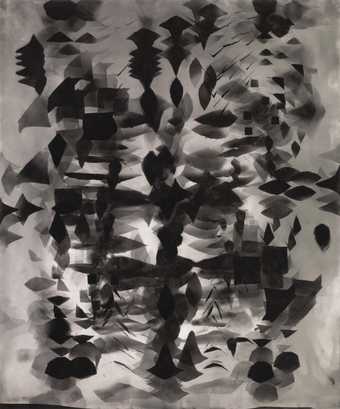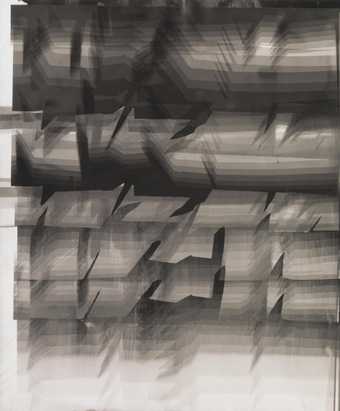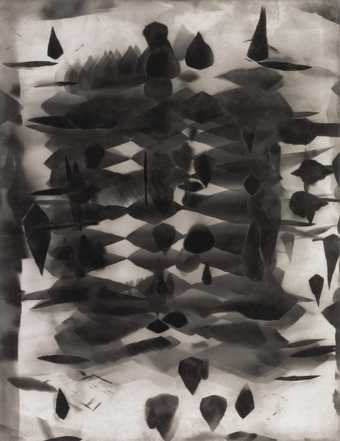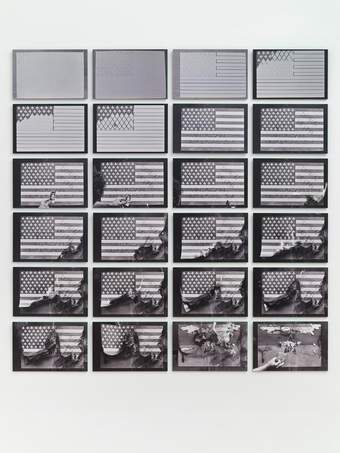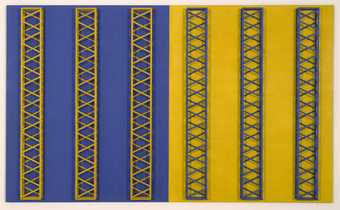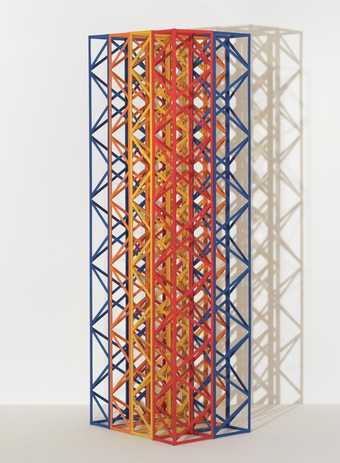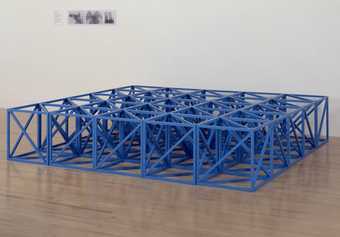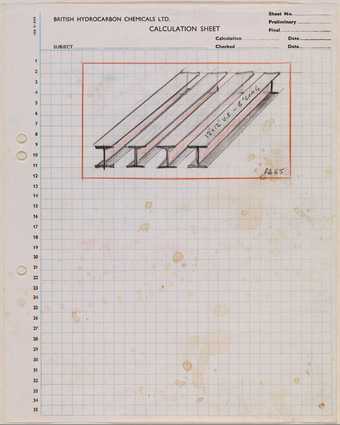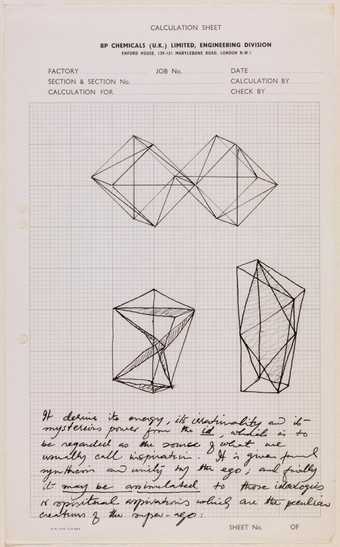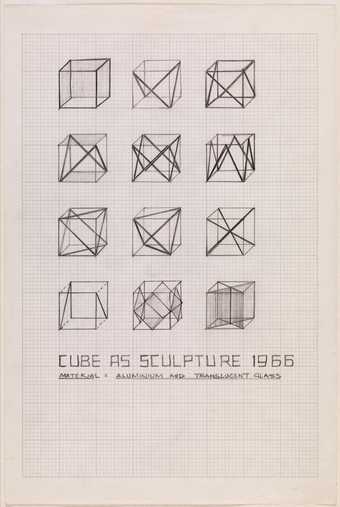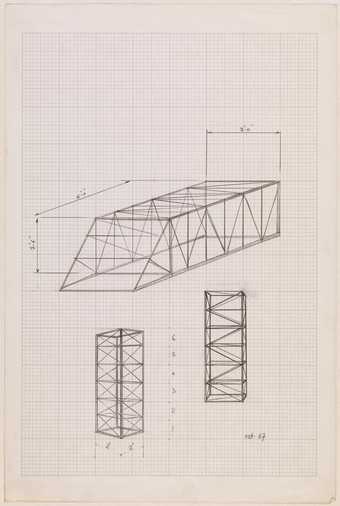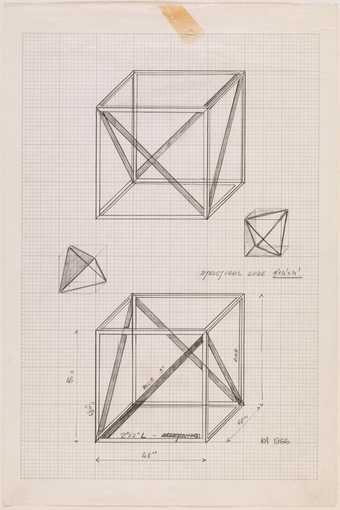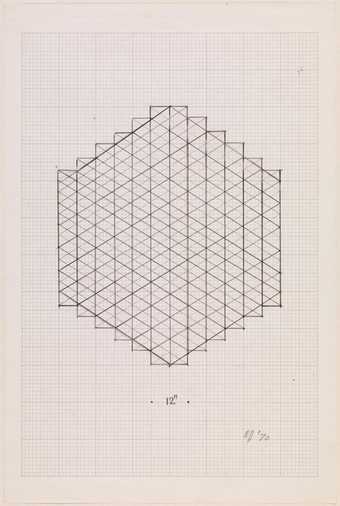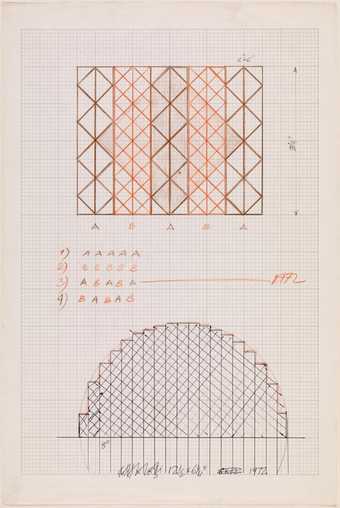
In Tate St Ives
- Artist
- Rasheed Araeen born 1935
- Medium
- Painted wood
- Dimensions
- Object:
914 × 914 × 914 mm (plinth dims- verified) - Collection
- Tate
- Acquisition
- Presented by Tate Members 2011
- Reference
- T13389
Summary
Lovers 1968 is a two-part movable sculpture made of painted wood. Each part is an open prism constructed out of a series of triangles, rotated and orientated in different ways. The work can be shown in two different configurations, either with the two parts next to each other, or on top of each other. Although it is not an interactive piece, Lovers demonstrates Araeen’s development of a minimalist tradition as well as his investment in kinetic art. It bears comparison with Zero to Infinity 1968–2007 (Tate T12756), conceived in the same year, which invites audiences to change the configuration of its elements, challenging its static structure and making flux part of the arrangement.
Araeen was born in Karachi in 1935 and moved to London in 1964. His pursuit of a new sculpture formed out of symmetrical structures led him to be considered one of the pioneers of minimalist sculpture in Britain. Lovers brings together various aspects of his work in this period, particularly the introduction of kinetic elements into minimalist structure and the use of the diagonal. Araeen started to use the diagonal while exploring how to achieve the most stable open structure using minimal means. According to engineering principles, this was a cube strengthened by diagonal struts bisecting each of its faces. Some artists and critics drew parallels between diagonal elements and Islamic art and architecture in the 1960s and 1970s. Araeen, however, has denied such a relationship and claimed that his investment in the diagonal derived from his education in civil engineering as well as his interest in early twentieth-century modernism, especially Russian constructivism and De Stijl. In Lovers, however, the diagonal lines are not attached to vertical lines as in his lattice structures, a fact noted by critic Patricia Bickers, who has observed that: ‘in the construction of the rectilinear Structures, the helical elements are independent of the vertical elements which frame them; only once in a piece of 1968 appropriately entitled Lovers, were diagonals allowed to “break out” of any vertical constraint’ (Patricia Bickers, ‘From Object to Subject’, in Ikon Gallery 1987, unpaginated).
Araeen has pinpointed the influence of sculptor Anthony Caro on his work, primarily because of the engineering materials he often employed; materials which, Araeen recalls, ‘had the appearance of having been picked up from a discarded heap of demolished engineering works’ (quoted in Niru Ratman, Rasheed Araeen: Before and After Minimalism 1959–1974, exhibition leaflet, Aicon Gallery, London 2010, unpaginated). There are also similarities between Araeen’s work and that of the American minimalist Sol LeWitt, who also used modular series and grids in his work, see for example Two Open Modular Cubes/Half-Off 1972, Tate T01865). This comparison is particularly evident in Araeen’s open cube structures. However, there are significant formal differences, particularly Araeen’s diagonal lines as well as the hand-assembled quality of the structures, which rarely have a pristine finish, unlike LeWitt’s objects.
In addition to Lovers, Araeen is represented in the Tate collection by 3Y+3B 1969 (Tate T12408), Rang Baranga 1969 (Tate T12409) and Zero to Infinity. Lovers has been shown in From Modernism to Postmodernism: Rasheed Araeen, A Retrospective: 1959–1987 at Ikon Gallery, Birmingham, in 1987 and in Before and After Minimalism 1959–1974 at Aicon Gallery, London, in 2010.
Further reading
From Modernism to Postmodernism: Rasheed Araeen, A Retrospective: 1959–1987, exhibition catalogue, Ikon Gallery, Birmingham 1987.
Rasheed Araeen, exhibition catalogue, South London Gallery, London 1994.
Rasheed Araeen: Before and After Minimalism, 1959–1974, exhibition catalogue, Aicon Gallery, London 2010.
Leyla Fakhr
November 2010
Does this text contain inaccurate information or language that you feel we should improve or change? We would like to hear from you.
Display caption
Araeen trained as a civil engineer, and his sculptures are constructed using geometric forms. Lovers combines two structures, each of which consists of a series of triangles that have been rotated and orientated in different ways. The work can be shown in two different configurations: either with the two parts next to each other, or on top of each other. This introduction of alternative possibilities challenges the idea of the artwork as a fixed object conceived by a single individual.
Gallery label, October 2016
Does this text contain inaccurate information or language that you feel we should improve or change? We would like to hear from you.
Explore
- abstraction(8,615)
-
- non-representational(6,161)
-
- geometric(3,072)
- emotions and human qualities(5,345)
-
- love(516)
- sex and relationships(833)
-
- couple(1,322)
You might like
-
Nalini Malani Untitled I
1970/2017 -
Nalini Malani Untitled II
1970/2017 -
Nalini Malani Untitled III
1970/2017 -
Rasheed Araeen Fire!
1975, printed 1984 -
Rasheed Araeen 3Y 3B
1969 -
Rasheed Araeen Rang Baranga
1969 -
Rasheed Araeen Zero to Infinity
1968–2007 -
Rasheed Araeen Drawing for Sculpture
1965 -
Rasheed Araeen Drawing for Sculpture
1968 -
Rasheed Araeen Drawing for Sculpture
1966 -
Rasheed Araeen Drawing for Sculpture
1967 -
Rasheed Araeen Drawing for Sculpture
1966 -
Rasheed Araeen Drawing for Sculpture
1970 -
Rasheed Araeen Drawing for Sculpture
1965 -
Rasheed Araeen Drawing for Sculpture
1972

